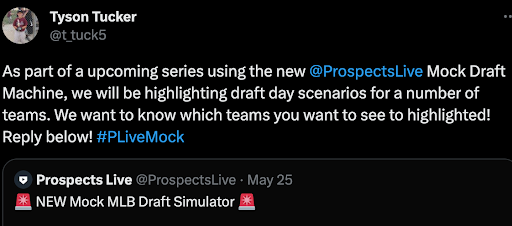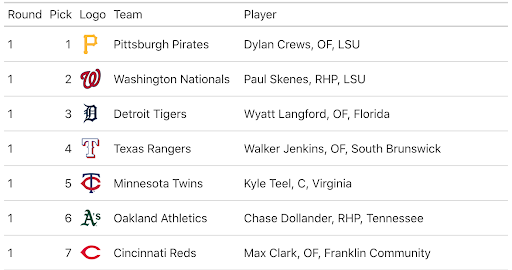As part of a new series accompanying the launch of the Prospects Live Mock Draft Machine, I’ll be highlighting draft day scenarios for a number of teams. What better way to use or new tool then put it to work before July 9th rolls around. To see where to start, I took to Twitter to see what team(s) the readers wanted to see me dive into.
The readers spoke and it felt apropos that the first team I saw mentioned was the much-discussed Cincinnati Reds. Thanks to a strong, young core of players like Jonathan India, Matt McLain, Spencer Steer, Hunter Greene, and of course Elly De La Cruz; it appears the buzz around the Redlegs is only intensifying. If you sensed a theme in the names I mentioned regarding the core of the team, you were right. The middle of the infield looks to be crowded for a long, long time. Cruz, India, McLain, Steer, Arroyo, Collier, and Marte are all names who should take the majority of playing time in the middle of the diamond for the foreseeable future.
Could those influence draft day decisions this coming July? We know teams don’t typically draft for Major League positional needs, but in a draft with strong frontline college pitching and stout prep outfielders; you have to wonder if the Cincy decision-makers sense a window creaking open and look to seize the opportunity. No matter what avenue they choose, the picks at hand offer plenty of intrigue.
Let’s set the scene on what the Reds have in this draft, specifically the first five rounds:
Picks:
7th overall ($6,275,200)
38th overall ($2,255,100)
43rd overall ($1,998,200)
74th overall ($975,100)
105th overall ($640,300)
141st overall ($451,100)
Overall, the Reds have the sixth-highest available bonus pool in the league, totaling $13,785,200. So what would likely scenarios be?
Scenario #1
In this simulation, things end up working out on the chalky side. The top five players on the Prospects Live Draft Board get selected in succession to each other, while the Oakland Athletics serve as a bit of a wildcard. Being in a situation where it looks as if they are a few years from playing competitive baseball, they aim for a high-upside, middle-of-the-diamond player in Arjun Nimmala. This allows the Reds to have their choice of the litter in regard to players like Dollander, Lowder, Teel, Meyer, Gonzalez, and Wilson.
As you can see, acting as the decision maker here, I chose Kyle Teel and paid him the full slot value. Teel is one of the premier college bats in this class, a pure athlete who gets high marks behind the plate. Some even say he plays catcher like a shortstop, which points towards a profile that stays behind the dish. Beyond that, you’re simply buying a high-level bat. A .418/.484/.673 slash line should tell you all you need to know.
Later in the draft, we are able to catch one of the prep shortstops as Adrian Santana finds his way down to pick No. 38. Feels as if with the amount of high-level prep SS in this class that one is bound to slip just a touch. We’re able to reign in Santana Jr. at just over slot value.
With our third selection, we are able to snag a potential frontline starter in Brandon Sproat. The stuff certainly suggests frontline, however, tweaks to the overall profile are needed. The organizational pitching infrastructure in place offers us to trust that the staff can make adjustments with Sproat and turn this into a great pick. The same can be said for Nick Maldonado who we snagged at pick No. 105 after selecting an extra high-upside prep middle infielder in Trent Caraway at 73 because you can never have enough of those. Jake Cunningham rounds out our five picks to offer just a touch of slot relief, but it’s certainly no throwaway. Cunningham possesses tools that are off the charts, putting it all together will be the test. If it clicks, we’re talking big leaguer.
Scenario #2
In this simulation, we catch a falling Max Clark. This is certainly not an outlandish happening. There's a real chance with the chaos of the MLB Draft that one of Jenkins or Clark finds their way to pick No. 7. For as long as this draft class has been talked about, Clark has been tabbed as one of, if not the best talent in the whole class. It’s an otherworldly high school stat line that includes a batting average in the .600s. Clark is more than a basher, it’s tools across the board. Speed, defense, plate discipline - Clark does it all well. Getting this type of upside at a position of need, at this type of value feels like a no-brainer for the Reds. We do have to pay a touch over-slot to make it happen but Clark feels worth it.
We find a similar profile with Colton Ledbetter at Pick No. 38. However, Ledbetter comes from the college ranks and may not have the sky-high ceiling of Clark - the profile is semi-reminiscent. Tanner Witt at pick No. 43 follows a similar path to that of Sproat and Maldonado from Scenario 1. Witt lacks the typical track record thanks to missing a large portion of 2023 due to injury but it’s a bet on the traits and pitching development infrastructure.
Wolters is a prep arm who has a major helium attached to his name right now. Up to 98 MPH, the big-bodied righty is gaining serious steam. If we’re lucky enough to see Wolters fall this far, we likely have to pay up to keep him from honoring his commitment to Arizona. We make it happen and go over-slot for Wolters but bring it back down to earth with the succeeding picks in Carson Roccaforte and Marcus Brown. A couple of guys who have seen major success at high-level college programs. Roccaforte falls in line with the Ledbetter profile and Brown is reminiscent of Trey Faltine, a fellow shortstop and Reds’ selection from 2022.
Conclusion
With the excitement level rising at the major league level, the opportunity within the 2023 Draft should offer just as much excitement for Cincinnati fans. Largely because this draft class is abnormally stout in its’ top fifty prospects. Just so happens the Reds hold three picks in the top 43. It’s an advantageous situation for a team looking to supplement an already young core. Flexibility is paramount in the chaos-filled MLB Draft. Reds’ brass will have plenty of that.
Who do you think the Reds should target at No. 7?









